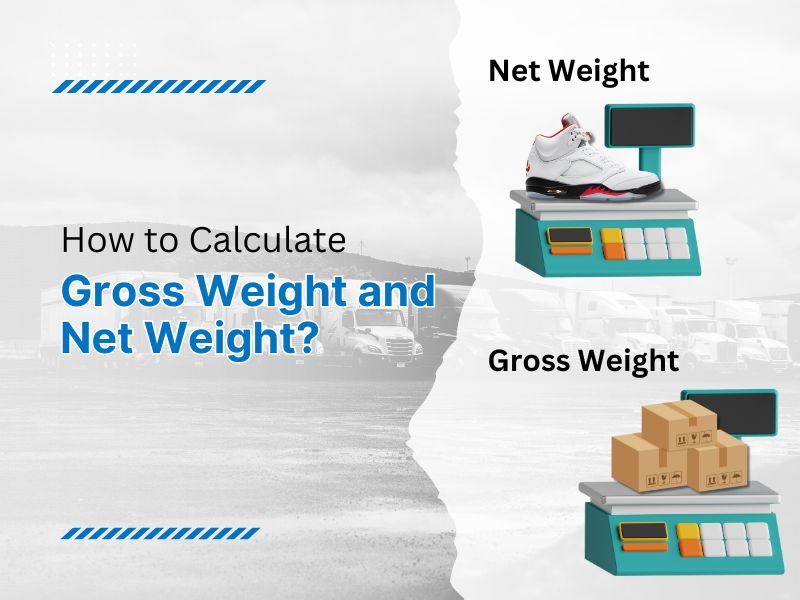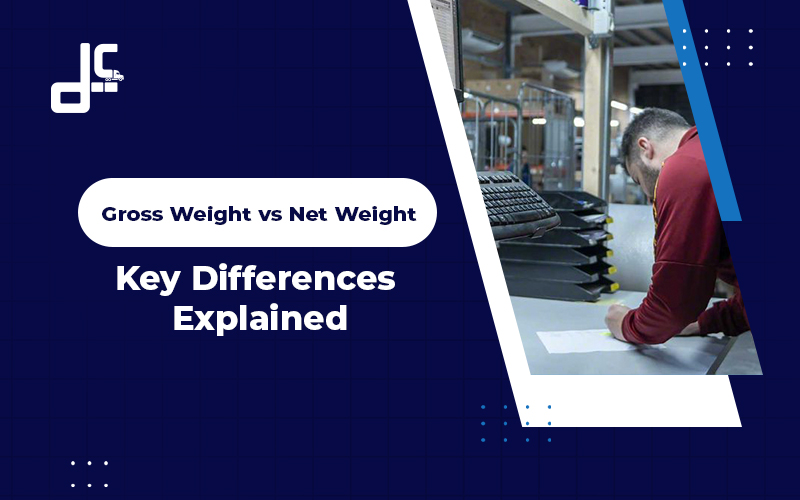When it comes to goods or packages, understanding the weight is crucial, whether you’re a consumer, a retailer, or a manufacturer. However, you’ll often see these two terms, “gross weight and net weight”, on packaging, shipping, labels, or product descriptions.
While they both may sound similar, they refer to two different things. Let’s unpack the meaning and difference between gross and net weight in this blog. Let’s dive right into it.
What is Gross Weight?
In simple words, gross weight is the total weight of a product, including the product plus all the additional packaging materials. This includes boxes, containers, protective wrapping, and sometimes even the pallet on which it’s placed for shipping.
Let’s take an example of a bag of sugar. The gross weight will include both the sugar and the bag it’s in.
Another example is a can of soup. Its gross weight includes the soup and the can.
Furthermore, if it’s part of a large delivery or bulk shipment, the gross weight might also include bubble wrap, cardboard boxes, foam inserts, tape, and the pallet.
What is Net Weight?
Simply put, net weight is the weight of just the product itself, nothing more. It does not include any packaging, wrapping, or containers.
When you look at the label, you’ll see the weight that tells you how much you’re getting for your money. It’s especially useful when comparing different brands or sizes in store or online.
To understand it better, let’s go back to our previous example of a bag of sugar and a can of soup.
- For a bag of sugar, the net weight will be only the sugar inside, not the bag.
- For a can of soup, the net weight will be just the soup, not the metal can.
What is the Difference Between Gross Weight vs Net Weight?
Each weight serves a different purpose and is important in its own way. It depends on whether you’re buying, selling, or shipping a product. To understand the difference between these two weights, let’s look at them side by side. Here’s a simple comparison table that breaks down gross vs net weight:
| Feature | Gross Weight | Net Weight |
| Definition | Total Weight of the product plus all packaging | Weight of the product alone |
| What It Includes | Product, packaging, and any shipping materials | Only the actual item |
| What It Excludes | Nothing, it includes every part of the shipment | All types of packaging and containers |
| Main Purpose | Helps calculate shipping costs, storage, and handling | Determining the amount of product being sold |
| Importance to Consumer | Manufacturers, distributors, and shipping companies | Consumers and retailers |
How to Calculate Gross Weight and Net Weight?

Having a basic understanding of net and gross weight is helpful, but sometimes, you may need to calculate them yourself. Whether you’re shipping products or simply curious about how much of a product you’re getting, doing a quick calculation can make things easier.
- Here’s how to calculate gross weight:
Net Weight = Gross Weight – Packaging Weight
For example, let’s say the total (gross) weight of a box of cereal is 600 grams, and the packaging (box and inner bag) weigh around100 grams:
Net Weight = 600g – 100g = 500g
This means you’re actually getting 500 grams of cereal.
- Here’s how to calculate net weight:
Gross Weight = Net Weight + Packaging Weight
For example, if a bottle of shampoo has a net weight of 250 grams and the bottle and cap weigh 50 grams:
Gross Weight = 250g + 50g = 300g
This means the total weight is 300g.
Also Read:- Dry Containers vs. Refrigerated Containers
What are Common Mistakes to Avoid When Calculating Gross Weight vs Net Weight?
While the concepts of gross weight and net weight are fairly simple, there are some common mistakes people make when calculating or using them. These errors can lead to incorrect pricing of, higher shipping costs, or confusion during sales and deliveries. Here are a few things to watch out for:
- Forgetting to Include All Packaging in Gross Weight
One of the most common mistakes is underestimating the gross weight by failing to include all packaging materials. It’s not just the outer box that counts; inner packaging, bubble wrap, plastic sleeves, pallets, and even labels should be considered. Leaving any of these out can result in weight miscalculations.
- Confusing Gross Weight with Net Weight on Labels
Sometimes, people mix up gross and net weight when labelling products or filling out shipping documents. Ensure that you’re filling in the correct weight for your packages to avoid any misunderstandings, returns, or fines.
- Using Estimated Packaging Weight Instead of Actual Weight
Estimating the weight of packaging instead of measuring it can throw off both gross and net weight calculations. Even small differences add up, especially in bulk shipments or commercial orders. Always try to use an accurate scale whenever possible.
- Ignoring Tare Weight When Needed
Tare weight is the weight of containers or packaging alone. Failing to subtract it correctly when calculating the net weight can lead to overcharging or incorrect quantity tracking.
- Not Considering Unit Differences (grams, kilograms, pounds, etc.)
Mixing up units is another common issue. For example, entering net weight in grams and gross weight in kilograms without converting them properly can create confusion and errors in documentation, pricing, or logistics.
Why are Gross and Net Weight Important?
Understanding the difference between net weight and gross weight isn’t just technical; it has real-world value for everyone involved in a product’s life cycle. From buying groceries to managing warehouse logistics, both weights play an important role. Here’s how theses two weights matters to different people:
- For Shoppers
Net weight tells you how much of the actual product you’re getting for your money. This is useful when you’re comparing different brands or sizes.
For example, two boxes of cereal might look the same, but one could have more net weight than the other. This way, you can compare the both boxes and avoid paying extra money for packaging.
- For Retailers
Retailers use net weight to set prices fairly and keep track of stock. It helps ensure that what’s listed on the shelf or online matches what’s being sold.
Clear net weight information also helps in preventing confusion between the size of a package and the amount of product inside, making it easier to manage the inventory and sales.
- For Manufacturers and Shippers
Gross weight is important when it comes to packing and transporting goods. Shipping companies charge based on the total weight, which includes the product and all packaging.
Knowing the gross weight helps prevent extra fees, keeps shipments within legal weight limits, and ensures safe loading for trucks, containers, or pallets. It’s a key factor in planning and efficiency.
Conclusion
In the end, gross weight and net weight are two different but related types of terms that are really important. Understanding both weights makes it easier to make smart choices, whether you’re buying everyday items, running a store, or shipping products across the country or around the world.
And if you’re looking for truck dispatch services that handle these details properly, then contact Dispatch Circle. They focus on accuracy, efficiency and smooth deliveries.
